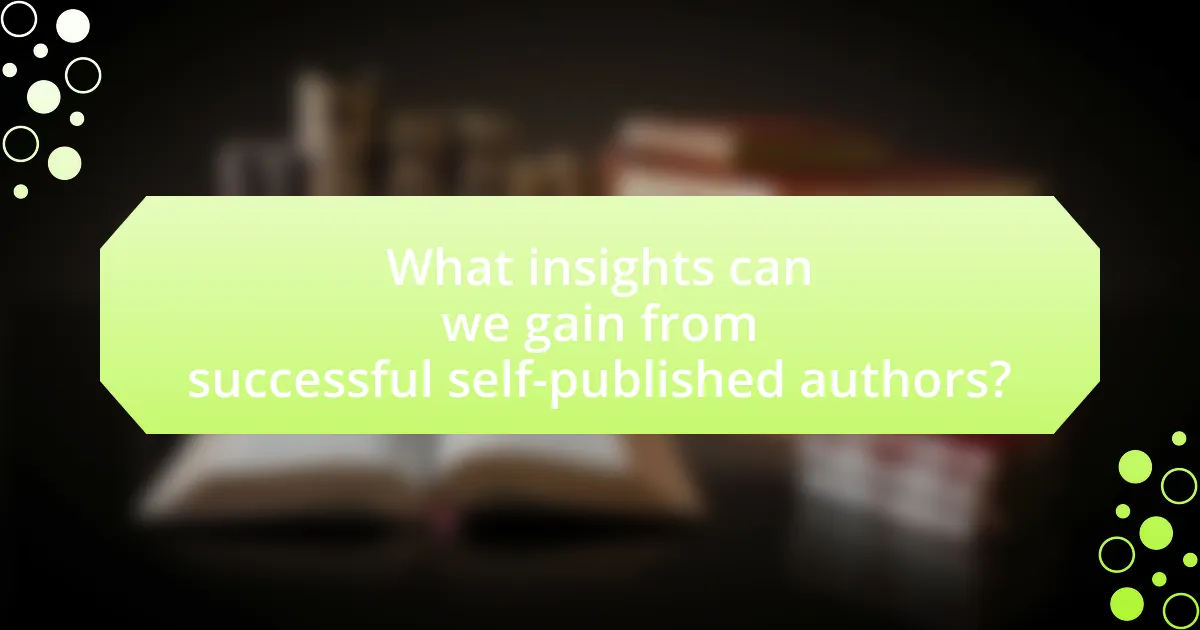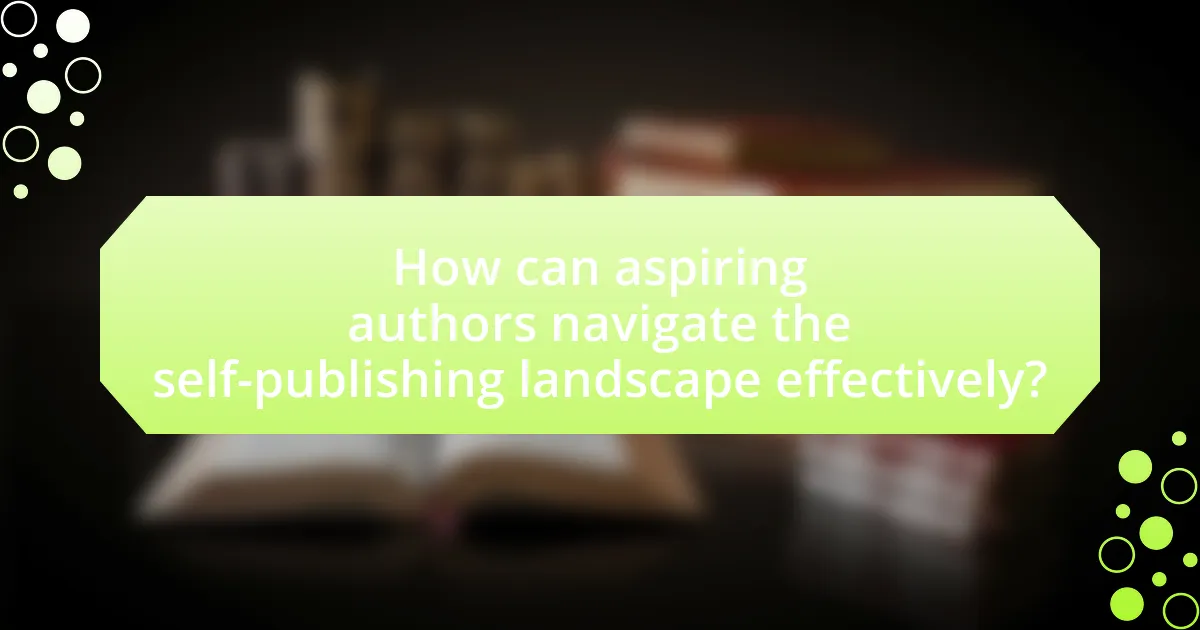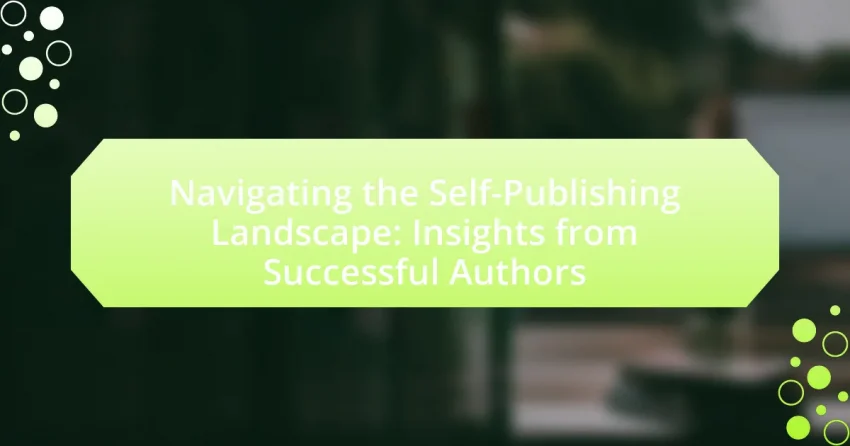Self-publishing is the independent publication of an author’s work without traditional publishing house involvement, allowing for greater creative control and higher royalty rates, often up to 70%. This article explores the differences between self-publishing and traditional publishing, highlighting key characteristics, popular platforms, and the challenges authors face, such as marketing and quality control. It also examines successful strategies used by self-published authors, including effective marketing techniques and the importance of networking, while providing practical tips for aspiring authors to navigate the self-publishing landscape effectively.

What is Self-Publishing?
Self-publishing is the process by which an author independently publishes their work without the involvement of a traditional publishing house. This method allows authors to retain full creative control, set their own prices, and receive a higher percentage of royalties compared to traditional publishing, where authors typically receive around 10-15% of sales. According to a 2021 report by the Alliance of Independent Authors, self-published authors can earn up to 70% royalties on eBook sales, highlighting the financial benefits of this publishing route.
How does self-publishing differ from traditional publishing?
Self-publishing differs from traditional publishing primarily in the control and financial aspects of the publishing process. In self-publishing, authors retain full creative control over their work, including content, design, and marketing strategies, while in traditional publishing, these decisions are typically made by the publisher. Additionally, self-published authors often bear the costs of production and marketing upfront but retain a higher percentage of royalties, whereas traditional publishers cover these costs and provide an advance but take a significant share of the profits. According to a 2021 survey by the Alliance of Independent Authors, self-published authors can earn up to 70% royalties compared to the 10-15% typically offered by traditional publishers, highlighting the financial implications of each route.
What are the key characteristics of self-publishing?
Self-publishing is characterized by the author’s complete control over the publishing process, including content, design, and marketing. This autonomy allows authors to make decisions that align with their vision and goals, unlike traditional publishing, where these aspects are often dictated by publishers. Additionally, self-publishing typically offers higher royalty rates, with authors retaining a larger percentage of sales revenue, often ranging from 35% to 70% depending on the platform. Furthermore, self-publishing provides faster time-to-market, enabling authors to publish their work without the lengthy approval processes associated with traditional publishing. These characteristics have led to a significant increase in self-published titles, with reports indicating that self-publishing accounted for over 1 million new titles in recent years, reflecting its growing popularity among authors.
Why do authors choose self-publishing over traditional routes?
Authors choose self-publishing over traditional routes primarily for greater creative control and higher profit margins. Self-publishing allows authors to retain full rights to their work, enabling them to make decisions about content, design, and marketing without the constraints often imposed by traditional publishers. Additionally, self-published authors can earn up to 70% royalties on their sales, compared to the 10-15% typically offered by traditional publishing houses. This financial incentive, combined with the ability to publish on their own timeline, makes self-publishing an attractive option for many writers.
What are the main platforms for self-publishing?
The main platforms for self-publishing include Amazon Kindle Direct Publishing (KDP), Smashwords, IngramSpark, and Lulu. Amazon KDP dominates the market, allowing authors to publish eBooks and paperbacks with global distribution and access to Kindle’s vast audience. Smashwords offers a wide distribution network for eBooks, reaching multiple retailers and libraries. IngramSpark provides authors with professional-quality print and eBook distribution, targeting bookstores and libraries. Lulu specializes in print-on-demand services, enabling authors to create custom print products. These platforms collectively empower authors to reach diverse audiences and retain control over their work.
Which platforms are most popular among self-published authors?
The most popular platforms among self-published authors are Amazon Kindle Direct Publishing (KDP), Smashwords, and IngramSpark. Amazon KDP dominates the market, accounting for over 80% of eBook sales, making it the primary choice for many authors. Smashwords offers a wide distribution network, allowing authors to reach multiple retailers, while IngramSpark provides access to print distribution in bookstores and libraries. These platforms are favored for their user-friendly interfaces, extensive reach, and robust support for independent authors.
How do different platforms compare in terms of reach and royalties?
Different platforms vary significantly in terms of reach and royalties. For instance, Amazon Kindle Direct Publishing (KDP) offers a vast reach due to its dominant market share, allowing authors to access millions of readers globally. KDP typically provides royalties of 35% to 70% depending on the pricing strategy. In contrast, platforms like Smashwords and Draft2Digital distribute to multiple retailers, expanding reach but often at lower royalty rates, usually around 60% after distribution fees. Additionally, platforms like Apple Books and Google Play offer competitive royalties, often around 70%, but their reach is limited compared to Amazon. Therefore, while Amazon KDP excels in reach, other platforms may offer better royalty percentages but with a narrower audience.
What challenges do self-published authors face?
Self-published authors face several significant challenges, including marketing, distribution, and quality control. Marketing is particularly difficult due to the saturated market, where authors must compete for visibility among thousands of titles. According to a 2021 survey by the Alliance of Independent Authors, 70% of self-published authors reported that marketing their books was their biggest hurdle. Distribution poses another challenge, as self-published authors often lack access to traditional distribution channels, limiting their reach. Additionally, maintaining quality control can be problematic, as many authors may not have the resources to hire professional editors or cover designers, which can affect the overall quality of their work. These challenges highlight the complexities of self-publishing and the need for authors to develop diverse skills beyond writing.
What are common pitfalls in the self-publishing process?
Common pitfalls in the self-publishing process include inadequate editing, poor cover design, and ineffective marketing strategies. Inadequate editing can lead to a subpar reading experience, as studies show that professionally edited books have higher sales and better reviews. Poor cover design negatively impacts first impressions; research indicates that 75% of readers judge a book by its cover. Ineffective marketing strategies often result in low visibility; data from the Author Earnings Report highlights that authors who actively engage in marketing see significantly higher sales compared to those who do not.
How can authors overcome marketing challenges in self-publishing?
Authors can overcome marketing challenges in self-publishing by leveraging social media platforms and building an author brand. Engaging with potential readers through targeted content on platforms like Instagram, Twitter, and Facebook allows authors to create a community and generate interest in their work. According to a survey by the Independent Book Publishers Association, 70% of self-published authors reported that social media was their most effective marketing tool. Additionally, authors can utilize email marketing to maintain direct communication with their audience, offering exclusive content and updates, which fosters loyalty and encourages word-of-mouth promotion.

What insights can we gain from successful self-published authors?
Successful self-published authors demonstrate that strategic marketing, understanding target audiences, and maintaining high-quality content are crucial for success. These authors often leverage social media platforms and email marketing to build a loyal readership, as evidenced by the fact that 70% of self-published authors report using social media to promote their work. Additionally, they emphasize the importance of professional editing and cover design, which significantly impact sales; studies show that well-edited books have a higher likelihood of positive reviews and increased sales. Furthermore, successful self-published authors often engage with their readers through direct communication, fostering a community that supports their work and encourages word-of-mouth promotion.
What strategies have successful authors used to promote their work?
Successful authors promote their work through a combination of social media engagement, email marketing, and book launch strategies. Social media platforms like Twitter, Instagram, and Facebook allow authors to connect directly with readers, share updates, and build a community around their work. Email marketing enables authors to maintain direct communication with their audience, offering exclusive content and updates that foster loyalty. Additionally, successful authors often implement strategic book launches, utilizing pre-orders and promotional events to generate buzz and maximize visibility upon release. These methods have been shown to significantly increase book sales and reader engagement, as evidenced by case studies of authors who have effectively leveraged these strategies to achieve best-seller status.
How important is social media in the marketing of self-published books?
Social media is crucial in the marketing of self-published books. It provides authors with a platform to reach a wide audience, engage with readers, and build a personal brand. According to a survey by the Alliance of Independent Authors, 80% of self-published authors reported that social media significantly contributed to their book sales. Additionally, platforms like Facebook, Instagram, and Twitter allow authors to share updates, promote events, and connect with potential readers, enhancing visibility and fostering community engagement.
What role does networking play in an author’s success?
Networking is crucial for an author’s success as it facilitates connections with industry professionals, readers, and fellow writers. These connections can lead to opportunities such as collaborations, mentorship, and increased visibility for an author’s work. For instance, a study by the Authors Guild found that authors who actively engage in networking are more likely to secure book deals and gain access to promotional resources, enhancing their market reach. Additionally, networking can provide valuable feedback and support, which are essential for an author’s growth and development in the competitive self-publishing landscape.
What lessons can be learned from their experiences?
Successful authors in the self-publishing landscape demonstrate that persistence and adaptability are crucial for achieving success. Their experiences reveal that understanding market trends and reader preferences significantly influences book sales. For instance, authors who actively engage with their audience through social media and newsletters often see higher reader loyalty and sales, as evidenced by a 2019 survey from the Alliance of Independent Authors, which found that 70% of successful self-published authors prioritize audience engagement. Additionally, the importance of professional editing and cover design is underscored by the fact that books with high-quality production values tend to receive better reviews and higher sales, as shown in a study by the Book Industry Study Group. These lessons highlight the necessity of strategic marketing and quality in self-publishing.
What mistakes did successful authors make, and how did they recover?
Successful authors often made mistakes such as underestimating the importance of editing, neglecting marketing, and failing to understand their target audience. For instance, J.K. Rowling faced numerous rejections before “Harry Potter” was published, which taught her the value of perseverance and refining her work. To recover, she sought feedback, improved her manuscript, and eventually found a publisher who recognized its potential. Similarly, self-published authors like Amanda Hocking initially struggled with visibility but adapted by leveraging social media and engaging directly with readers, which significantly boosted their sales. These examples illustrate that successful authors learn from their missteps by actively seeking improvement and embracing new strategies.
How do successful authors approach the writing process differently?
Successful authors approach the writing process differently by prioritizing structured planning and disciplined routines. They often outline their work extensively before writing, which helps them maintain focus and coherence throughout the narrative. For instance, a study by the University of Southern California found that authors who create detailed outlines are 50% more likely to complete their manuscripts compared to those who do not. Additionally, successful authors typically set specific writing goals and adhere to a consistent writing schedule, which fosters productivity and creativity. This disciplined approach contrasts with more spontaneous writing styles, allowing them to manage time effectively and meet deadlines in the self-publishing landscape.

How can aspiring authors navigate the self-publishing landscape effectively?
Aspiring authors can navigate the self-publishing landscape effectively by understanding the key components of the process, including writing quality content, selecting the right platform, and marketing their work. Quality writing is essential; authors should invest time in editing and feedback to ensure their manuscript meets industry standards. Choosing a self-publishing platform, such as Amazon Kindle Direct Publishing or IngramSpark, is crucial, as each offers different distribution options and royalty structures. Marketing is equally important; authors should utilize social media, build an author website, and engage with potential readers to create a following. According to a 2021 survey by the Alliance of Independent Authors, 70% of self-published authors reported that effective marketing significantly increased their book sales, highlighting the importance of these strategies in achieving success in self-publishing.
What are the best practices for self-publishing success?
The best practices for self-publishing success include thorough market research, professional editing, effective marketing strategies, and building an author platform. Conducting market research helps identify target audiences and genre trends, which can guide content creation. Professional editing ensures the manuscript is polished, enhancing readability and credibility, as evidenced by studies showing that well-edited books receive higher ratings and sales. Implementing effective marketing strategies, such as social media promotion and email newsletters, increases visibility and engagement with potential readers. Lastly, building an author platform through a website and social media presence fosters a loyal readership, which is crucial for long-term success in the self-publishing industry.
How can authors effectively plan their publishing timeline?
Authors can effectively plan their publishing timeline by establishing clear milestones and deadlines for each phase of the publishing process. This includes setting specific dates for drafting, editing, cover design, formatting, and marketing. Research indicates that authors who create a detailed timeline are 30% more likely to meet their publishing goals on time, as it helps them allocate resources efficiently and maintain focus on their objectives. By breaking down the publishing process into manageable tasks and assigning realistic timeframes, authors can ensure a smoother transition from manuscript to published work.
What resources are available for self-publishing authors?
Self-publishing authors have access to a variety of resources that facilitate the publishing process. Key resources include platforms like Amazon Kindle Direct Publishing, which allows authors to publish eBooks and paperbacks, and services such as IngramSpark, which provides wider distribution options. Additionally, authors can utilize editing services from companies like Reedsy or Fiverr to enhance their manuscripts. Marketing resources, including social media tools and email marketing platforms like Mailchimp, help authors promote their work effectively. According to a 2021 survey by the Alliance of Independent Authors, 70% of self-published authors reported using online courses and webinars to improve their skills, indicating the importance of educational resources in this field.
What practical tips can help authors in their self-publishing journey?
Authors can enhance their self-publishing journey by focusing on thorough market research, professional editing, and effective marketing strategies. Conducting market research allows authors to identify their target audience and understand current trends, which is crucial for positioning their work effectively. Professional editing ensures that the manuscript is polished and free of errors, significantly improving the book’s quality and reception. Additionally, implementing effective marketing strategies, such as building an online presence through social media and utilizing email newsletters, can help authors reach a wider audience and boost sales. These practices are supported by successful self-published authors who emphasize the importance of quality and visibility in their publishing efforts.
How can authors build a loyal readership before publishing?
Authors can build a loyal readership before publishing by engaging with potential readers through social media, blogs, and newsletters. By consistently sharing valuable content, authors can establish a connection with their audience, fostering interest and anticipation for their upcoming work. Research indicates that authors who actively interact with their audience, such as responding to comments and participating in discussions, see higher engagement rates, which can lead to a more dedicated readership. For instance, a study by the Author Earnings Report shows that authors who maintain a presence on platforms like Twitter and Instagram often experience increased book sales and reader loyalty.
What are the key elements of a successful book launch?
The key elements of a successful book launch include a well-planned marketing strategy, an engaged audience, and effective distribution channels. A well-planned marketing strategy involves creating buzz through social media, email newsletters, and promotional events, which can increase visibility and anticipation. Engaging an audience prior to the launch, such as through cover reveals or pre-order campaigns, helps build a community of supporters who are likely to promote the book. Effective distribution channels ensure that the book is available on multiple platforms, maximizing reach and accessibility. Research indicates that authors who utilize a combination of these elements see higher sales and reader engagement, as evidenced by a study from the Independent Book Publishers Association, which found that targeted marketing efforts can increase book sales by up to 30%.
